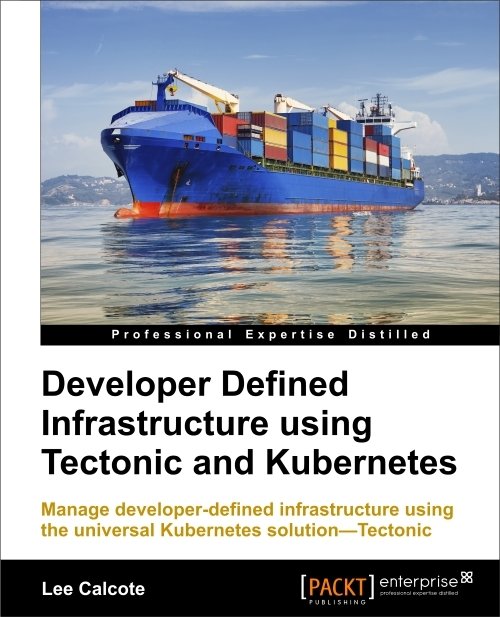Characterizing and Contrasting Kuhn-tey-ner
Awr-kuh-streyt-ors
All Things Open, October 2016
Lee Calcote
Lee Calcote





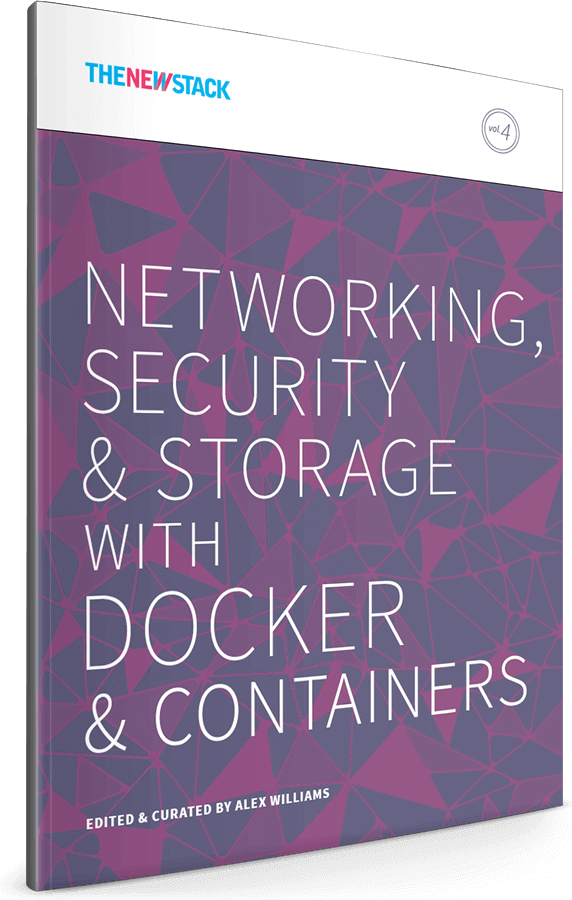
clouds, containers, infrastructure,
applications and their management
Show of Hands


[k uh n- tey -ner]
[ awr -k uh -streyt-or]
Definition:
Fleet
Nomad
Swarm
Kubernetes
Mesos+Marathon
CaaS
(Stay tuned for updates to presentation and book)

One size does not fit all.
A strict apples-to-apples comparison is inappropriate and not the objective, hence characterizing and contrasting.

Let's not go here today.
Container orchestrators may be in te rm ix ed.
Categorically Speaking
-
Genesis & Purpose
-
Support & Momentum
-
Host & Service Discovery
-
Scheduling
-
Modularity & Extensibility
-
Updates & Maintenance
-
Health Monitoring
-
Networking & Load-Balancing
-
High Availability & Scale
Hypervisor
Manager
Elements
-
Compute
-
Network
-
Storage
Container
Orchestrator
Elements
- Host (Node)
- Container
- Task
- Service
- Volume
- Applications
≈
≈
Core
Capabilities
-
Cluster Management
-
Host Discovery
-
Host Health Monitoring
-
-
Scheduling
-
Orchestrator Updates and Host Maintenance
-
Service Discovery
-
Networking and Load-Balancing
Additional
Key Capabilities
-
Application Health Monitoring
-
Application Deployments
-
Application Performance Monitoring

Nomad
Genesis & Purpose
- designed for both long lived services and short lived batch processing workloads.
- cluster manager with declarative job specifications.
- ensures constraints are satisfied and resource utilization is optimized by efficient task packing.
- supports all major operating systems and virtualized, containerized or standalone workloads.
- written in Go.

Support & Momentum
- Project began June 2015 has 113 contributors over 16 months
-
Current release v0.4
-
v0.5 to be in a week or so
-
Nomad Enterprise offering aimed for Q1-Q2 next year.
-
-
Supported and governed by HashiCorp
-
Hashiconf US '15 had ~300 attendees
-
Hashiconf EU '16 had ~320 attendees
-
HashiConf US '16 had ~ 500 attendees
-

Nomad Architecture

Nomad is a single binary, both for clients and servers, and requires no external services for coordination or storage.
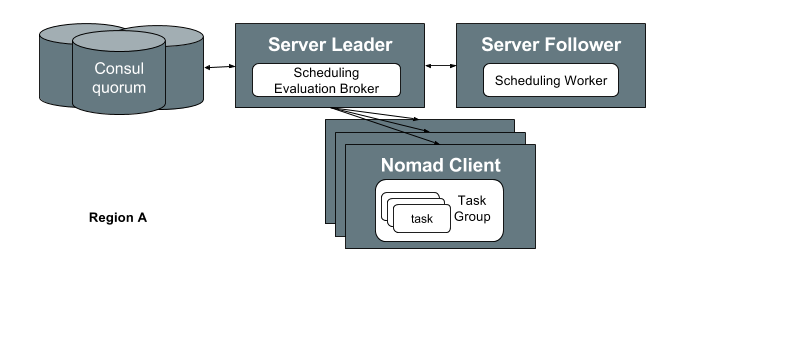
Host &
Service Discovery
Host Discovery
-
Gossip protocol - Serf is used
-
Docker multi-host networking and Swarmkit use Serf, too
-
-
Servers advertise full set of Nomad servers to clients via heartbeats every 30 seconds
-
Creating federated clusters is simple
Service Discovery
-
Nomad integrates with Consul to provide service discovery and monitoring.
-



Scheduling
- two distinct phases, feasibility checking and ranking.
-
optimistically concurrent
-
enabling all servers to participate in scheduling decisions which increases the total throughput and reduces latency
-
-
three scheduler types used when creating jobs:
-
service, batch and system
-
nomad plan point-in-time-view of what Nomad will do
-

Modularity & Extensibility
Task drivers
-
Used by Nomad clients to execute a task and provide resource isolation.
-
By having extensible task drivers are important for flexibility to support a broad set of workloads.
-
Does not currently support pluggable task drivers,
-
Have to iImplement task driver interface and compile Nomad binary.
-

Updates &
Maintenance
Nodes
-
Drain allocations on a running node.
-
integrates with tools like Packer, Consul, and Terraform to support building artifacts, service discovery, monitoring and capacity management.
Applications
-
Log rotation (stderr and stdout)
-
no log forward s upport , yet
-
-
Rolling updates (via the `update` block in the job specification).

Health Monitoring
Nodes
- Node health monitoring is done via heartbeats, so Nomad can detect failed nodes and migrate the allocations to other healthy clients.
Applications
-
currently http, tcp and script
-
In the future Nomad will add support for more Consul checks.
-
nomad alloc-status reports actual resource utilization

Networking & Load-Balancing
Networking
-
Dynamic ports are allocated in a range from 20000 to 60000.
-
Shared IP address with Node
Load-Balancing
-
Consul provides DNS-based load-balancing

Secrets Management
- Nomad agents provide secure integration with Vault
- for all tasks and containers it spins up
- gives secure access to Vault secrets through a workflow which minimizes risk of secret exposure during bootstrapping.

High Availability & Scale
-
distributed and highly available, using both leader election and state replication to provide availability in the face of failures.
-
shared state optimistic scheduler
-
only open source implementation.
-
only open source implementation.
- 1,000,0000 across 5,000 hosts and scheduled in 5 min.
-
Built for managing multiple clusters / cluster federation.

- easier to use
- a single binary for both clients and servers
- supports different non-containerized tasks
- arguably the most advanced scheduler design
- upfront consideration of federation / hybrid cloud
- broad OS support
-
Outside of scheduler, comparatively less sophisticated
-
Young project
-
Less relative momentum
-
Less relative adoption
-
Less extensible / pluggable

Docker Swarm
Docker Swarm 1.12
aka
Swarmkit or Swarm mode
Genesis & Purpose
-
Swarm is simple and easy to setup.
-
Responsible for the clustering and scheduling aspects of orchestration.
-
Originally an imperative system, now declarative
-
Swarm’s architecture is not complex as those of Kubernetes and Mesos
-
Written in Go, Swarm is lightweight, modular and extensible
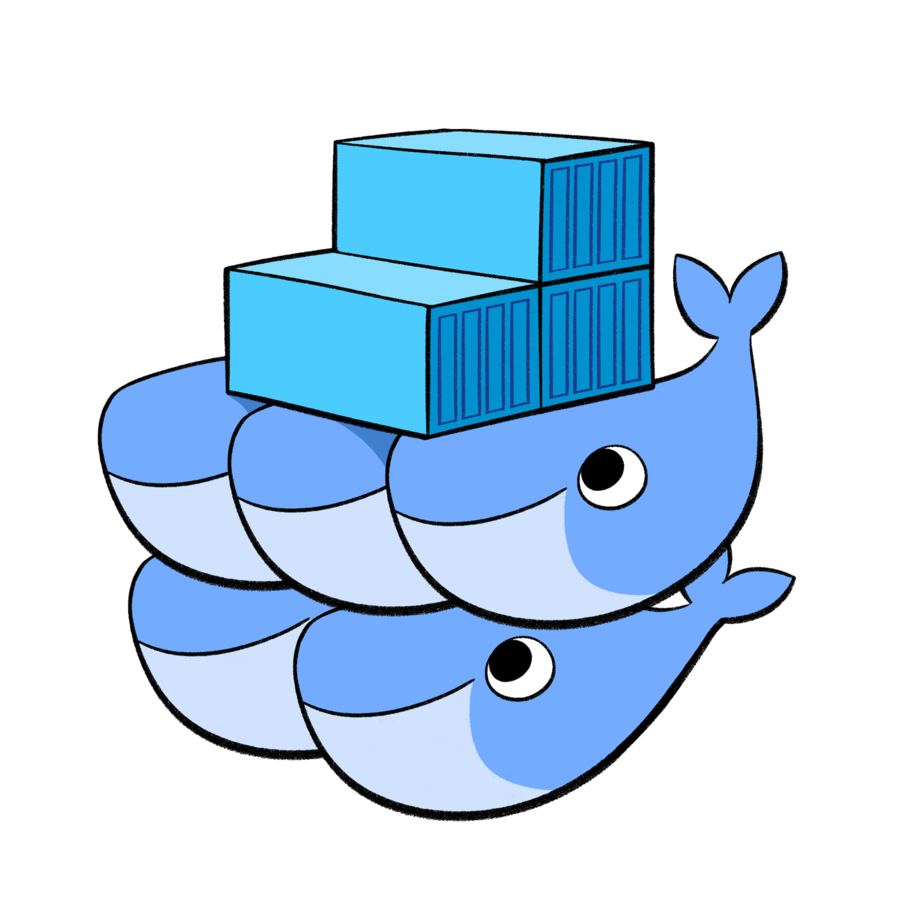
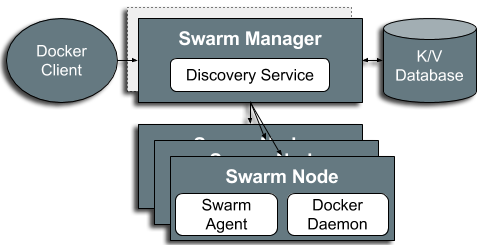
Docker Swarm 1.11 (Standalone)
Docker Swarm Mode 1.12 (Swarmkit)
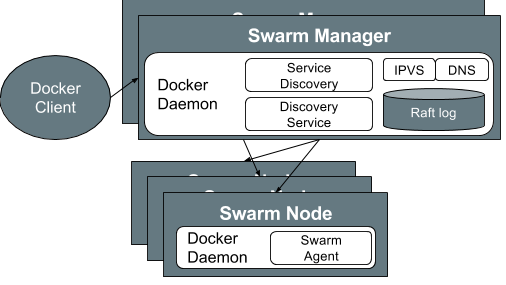
Support & Momentum
-
Contributions:
-
Standalone: ~3,000 commits, 12 core maintainers (140 contributors)
-
Swarmkit: ~2,000 commits, 12 core maintainers (40 contributors)
-
-
~250 Docker meetups worldwide
-
Production-ready:
-
Standalone announced ~12 months ago (Nov 2015)
-
Swarmkit announced ~3 month ago (July 2016)
-

Host & Service Discovery
Host Discovery
-
used in the formation of clusters by the Manager to discover for Nodes (hosts).
-
Like Nomad, uses Hashicorp's go MemDB for storing cluster state
-
Pull model - where worker checks-in with the Manager
-
Rate Control - of checks-in with Manager may be controlled at Manager - add jitter
-
Workers don't need to know which Manager is active; Follower Managers will redirect Workers to Leader
Service Discovery
-
Embedded DNS and round robin load-balancing
-
Services are a new concept

Scheduling
-
Swarm’s scheduler is pluggable
-
Swarm scheduling is a combination of strategies and filters/constraint:
-
Strategies
-
Random, Binpack
-
Spread*
-
Plugin?
-
-
Filters
-
container constraints (affinity, dependency, port) are defined as environment variables in the specification file
-
node constraints (health, constraint) must be specified when starting the docker daemon and define which nodes a container may be scheduled on.
-
-

Swarm Mode only supports Spread
Modularity & Extensibility
Ability to remove batteries is a strength for Swarm:
-
Pluggable scheduler -
Pluggable network driver
-
Pluggable distributed K/V store -
Docker container engine runtime-only
-
Pluggable authorization (in docker engine)*

Updates & Maintenance
Nodes
-
Nodes may be Active, Drained and Paused
-
Manager weights are used to drain or pause Managers
-
-
Manual swarm manager and worker updates
Applications
-
Rolling updates now supported
-
--update-delay
-
--update-parallelism
-
--update-failure-action
-

Health Monitoring
Nodes
-
Swarm monitors the availability and resource usage of nodes within the cluster
Applications
- One health check per container may be run
-
check container health by running a command inside the container
- --interval=DURATION (default: 30s)
- --timeout=DURATION (default: 30s)
- --retries=N (default: 3)
-
check container health by running a command inside the container

Networking & Load-Balancing
-
Swarm and Docker’s multi-host networking are simpatico
-
provides for user-defined overlay networks that are micro-segmentable
-
uses a gossip protocol for quick convergence of neighbor table
-
facilitates container name resolution via embedded DNS server (previously via etc/hosts)
-
-
You may bring your own network driver
-
Load-balancing based on IPVS
-
expose Service's port externally
-
L4 load-balancer; cluster-wide port publishing
-
-
Mesh routing
-
-
send a request to any one of the nodes and it will be routed automatically
-
send a request to any one of the nodes and it will be internally load balanced
-

Secrets Management
Not yet...
tracking toward 1.13

High Availability & Scale
-
Managers may be deployed in a highly-available configuration
-
Active/Standby - only one active Leader at-a-time
-
Maintain odd number of managers
-
-
Rescheduling upon node failure
-
No r ebalancing upon node addition to the cluster
-
-
Does not support multiple failure isolation regions or federation
-
although, with caveats, federation is possible.
-


Scaling swarm to 1,000 AWS nodes and 50,000 containers

-
Suitable for orchestrating a combination of infrastructure containers
-
Has only recently added capabilities falling into the application bucket
-
-
Swarm is a young project
-
advanced features forthcoming
-
natural expectation of caveats in functionality
-
-
No rebalancing, autoscaling or monitoring, yet
-
Only schedules Docker containers, not containers using other specifications.
-
Does not schedule VMs or non-containerized processes
-
Does not provide support for batch jobs
-
-
Need separate load-balancer for overlapping ingress ports
-
While dependency and affinity filters are available, Swarm does not provide the ability to enforce scheduling of two containers onto the same host or not at all.
-
Filters facilitate sidecar pattern. No “pod” concept.
-
-
Swarm works. Swarm is simple and easy to deploy.
-
1.12 eliminated need for much, but not all third-party software
-
Facilitates earlier stages of adoption by organizations viewing containers as faster VMs
-
now with built-in functionality for applications
-
-
Swarm is easy to extend, if can already know Docker APIs, you can customize Swarm
-
Still modular, but has stepped back here.
-
Moving very fast; eliminating gaps quickly.
Kubernetes
Genesis & Purpose
-
an opinionated framework for building distributed systems
-
or as its tagline states "an open source system for automating deployment, scaling, and operations of applications."
-
-
Written in Go, Kubernetes is lightweight, modular and extensible
-
considered a third generation container orchestrator led by Google, Red Hat and others.
-
bakes in load-balancing, scale, volumes, deployments, secret management and cross-cluster federated services among other features.
-
-
Declaratively, opinionated with many key features included

Kubernetes Architecture
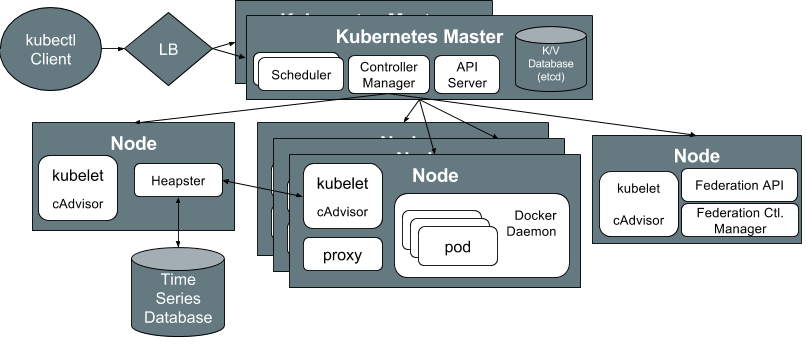

Support & Momentum
-
Kubernetes is young (about two years old)
-
Announced as production-ready 15 months ago (July 2015)
-
-
Project currently has over 1,000 commits per month (~38,000 total)
-
made by about 100 (862 total) Kubernauts (Kubernetes enthusiasts)
-
~5,000 commits made in 1.3 release (1.4 is latest)
-
-
Under the governance of the Cloud Native Computing Foundation
-
Robust set of documentation and ~90 meetups

Host & Service Discovery
Host Discovery
-
by default, the node agent (kubelet) is configured to register itself with the master (API server)
-
automating the joining of new hosts to the cluster
-
Service Discovery
Two primary modes of finding a Service
-
DNS
-
SkyDNS is deployed as a cluster add-on
-
-
environment variables
-
environment variables are used as a simple way of providing compatibility with Docker links-style networking
-

Scheduling
-
By default, scheduling is handled by kube-scheduler.
-
Pluggable
-
Selection criteria used by kube-scheduler to identify the best-fit node is defined by policy:
-
Predicates (node resources and characteristics):
-
PodFitPorts , PodFitsResources, NoDiskConflict , MatchNodeSelector, HostName , ServiceAffinit, LabelsPresence
-
-
Priorities (weighted strategies used to identify “best fit” node):
-
LeastRequestedPriority, BalancedResourceAllocation, ServiceSpreadingPriority, EqualPriority
-
-

Modularity &
Extensibility
-
One of Kubernetes strengths its pluggable architecture and it being an extensible platform
-
Choice of:
-
database for service discovery or network driver
-
container runtime
-
users may choose to run Docker with Rocket containers
-
-
-
Cluster add-ons
-
optional system components that implement a cluster feature (e.g. DNS, logging, etc.)
-
shipped with the Kubernetes binaries and are considered an inherent part of the Kubernetes clusters
-

Updates & Maintenance
Applications
-
Deployment objects automate deploying and rolling updating applications.
-
Support for rolling back deployments
Kubernetes Components
-
Consistently backwards compatible
-
Upgrading the Kubernetes components and hosts is done via shell script
-
Host maintenance - mark the node as unschedulable.
-
existing pods are vacated from the node
-
prevents new pods from being scheduled on the node
-

Health Monitoring
Nodes
-
Failures - actively monitors the health of nodes within the cluster
-
via Node Controller
-
-
Resources - usage monitoring leverages a combination of open source components:
-
cAdvisor, Heapster, InfluxDB, Grafana
-
Applications
-
three types of user-defined application health-checks and uses the Kubelet agent as the the health check monitor
-
HTTP Health Checks, Container Exec, TCP Socket
-
Cluster-level Logging
-
collect logs which persist beyond the lifetime of the pod’s container images or the lifetime of the pod or even cluster
-
standard output and standard error output of each container can be ingested using a Fluentd agent running on each node
-

Networking & Load-Balancing
…enter the Pod
-
atomic unit of scheduling
-
flat networking with each pod receiving an IP address
-
no NAT required, port conflicts localized
-
intra-pod communication via localhost
Load-Balancing
-
Services provide inherent load-balancing via kube-proxy:
-
runs on each node of a Kubernetes cluster
-
reflects services as defined in the Kubernetes API
-
supports simple TCP/UDP forwarding and round-robin and Docker-links-based service IP:PORT mapping.
-

Secrets Management
-
Secrets are used by container in a pod either:
-
mounted as data volumes
-
exposed as environment variables
-
-
None of the pod’s containers will start until all the pod’s volumes are mounted.
-
Individual secrets are limited to 1MB in size.
- Secrets are created and accessible within a given namespace, not cross-namespace.
High Availability & Scale
-
Each master component may be deployed in a highly-available configuration.
-
Active/Standby configuration
-
-
Federated clusters / multi-region deployments
Scale
-
v1.2 support for 1,000 node clusters
-
v1.3 supports 2,000 node clusters
-
Horizontal Pod Autoscaling (via Replication Controllers).
-
Cluster Autoscaling (if you're running on GCE with AWS support is coming soon).


-
Only runs containerized applications
-
For those familiar with Docker-only, Kubernetes requires understanding of new concepts
-
Powerful frameworks with more moving pieces beget complicated cluster deployment and management.
-
-
Lightweight graphical user interface
-
Does not provide as sophisticated techniques for resource utilization as Mesos
-
Kubernetes can schedule docker or rkt containers
-
Inherently opinionated w/functionality built-in.
-
-
relatively easy to change its opinion
-
little to no third-party software needed
-
builds in many application-level concepts and services (petsets, jobsets, daemonsets, application packages / charts, etc.)
-
advanced storage/volume management
-
-
project has most momentum
-
project is arguably most extensible
-
thorough project documentation
-
Supports multi-tenancy
-
Multi-master, cross-cluster federation, robust logging & metrics aggregation
Mesos
+
Marathon
Genesis & Purpose
-
Mesos is a distributed systems kernel
-
stitches together many different machines into a logical computer
-
-
Mesos has been around the longest (launched in 2009)
-
and is arguably the most stable, with highest (proven) scale currently
-
-
Mesos is written in C++
-
with Java, Python and C++ APIs
-
-
Marathon as a Framework
-
Marathon is one of a number of frameworks (Chronos and Aurora other examples) that may be run on top of Mesos
-
Frameworks have a scheduler and executor. Schedulers get resource offers. Executors run tasks.
-
Marathon is written in Scala
-

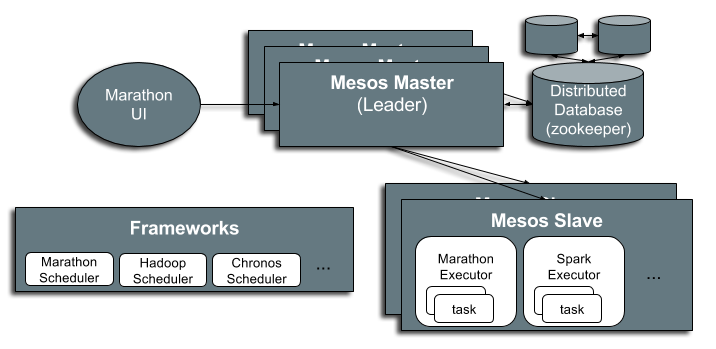
Mesos Architecture
Support & Momentum

-
MesosCon 2015 in Seattle had 700 attendees
-
up from 262 attendees in 2014
-
-
Mesos had 78 contributors
-
Marathon had 217 contributors
-
Under the governance of Apache Foundation
-
Mesos is used by Twitter, AirBnb, eBay, Apple, Cisco, Yodle
-
Marathon is used by Verizon and Samsung
Host &
Service Discovery
-
Mesos-DNS generates an SRV record for each Mesos task
-
including Marathon application instances
-
-
Marathon will ensure that all dynamically assigned service ports are unique
-
Mesos-DNS is particularly useful when:
-
apps are launched through multiple frameworks (not just Marathon)
-
you are using an IP-per-container solution like Project Calico
-
you use random host port assignments in Marathon
-

Scheduling
-
Two level scheduler
-
First level scheduling happens at mesos master based on allocation policy , which decides which framework get resources.
-
Second level scheduling happens at Framework scheduler , which decides what tasks to execute.
-
-
Provide reservations, over-subscriptions and preemption.

Modularity & Extensibility
Frameworks
-
multiple available
-
may run multiple frameworks
Modules
-
extend inner workings of Mesos by creating and using shared libraries that are loaded on demand
-
many types of Modules
-
Replacement, Isolator, Allocator, Authentication, Hook, Anonymous
-

Updates & Maintenance
Nodes
- Mesos has maintenance mode
-
Mesos backwards compatible from v1.0 forward
-
Marathon ?
Applications
-
Marathon can be instructed to deploy containers based on that component using a blue/green strategy
-
where old and new versions co-exist for a time.
-

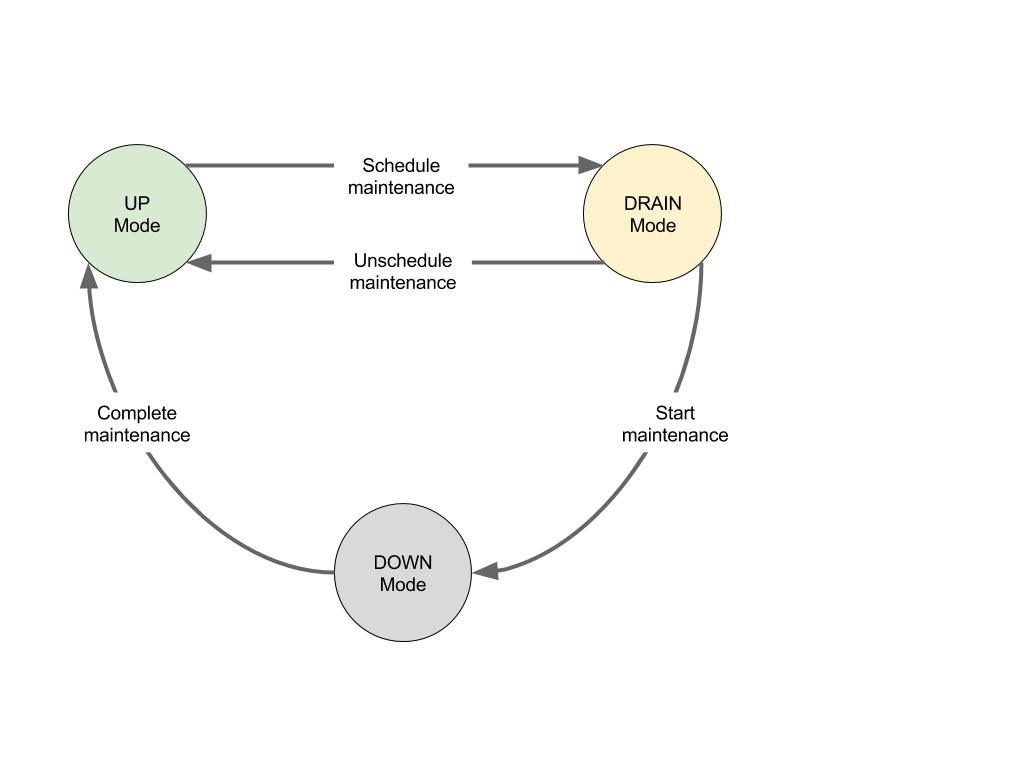
Health Monitoring
Nodes
-
Master tracks a set of statistics and metrics to monitor resource usage
Applications
-
support for health checks (HTTP and TCP)
-
an event stream that can be integrated with load-balancers or for analyzing metrics

Networking & Load-Balancing
Networking
-
An IP per Container
-
No longer share the node's IP
-
Helps remove port conflicts
-
Enables 3rd party network drivers
-
-
Container Network Interface (CNI) isolator with MesosContainerizer
Load-Balancing
-
Marathon offers two TCP/HTTP proxies
-
A simple shell script and a more complex one called marathon-lb that has more features.
-
Pluggable (e.g. Traefic for load-balancing)
-

Secrets Management
Not yet.
Only supported by Enterprise DC/OS
- Secrets shorter than eight characters may not be accepted by Marathon.
- By default, you cannot store a secret larger than 1MB.
High Availability & Scale
-
A strength of Mesos’s architecture
-
requires masters to form a quorum using ZooKeeper (point of failure)
-
only one Active (Leader) master at-a-time in Mesos and Marathon
-
-
Scale is a strong suit for Mesos. TBD for Marathon.
-
Great at asynchronous jobs. High availability built-in.
-
Referred to as the “golden standard” by Solomon Hykes, Docker CTO.
-

-
Universal Containerizer
-
abstract away from docker, rkt, kurma?, runc, appc
-
-
Can run multiple frameworks, including Kubernetes and Swarm.
-
Supports multi-tenancy.
-
Good for Big Data shops and job / task-oriented workloads.
-
Good for mixed workloads and with data-locality policies
-
-
Mesos is powerful and scalable, battle-tested
-
Good for multiple large things you need to do 10,000+ node cluster system
-
-
Marathon UI is young, but promising.

-
Still needs 3rd party tools
-
Marathon interface could be more Docker friendly (hard to get at volumes and registry)
-
May need a dedicated infrastructure IT team
-
an overly complex solution for small deployments
-
Summary

A high-level perspective of the container orchestrator spectrum .
Lee Calcote





Thank you. Questions?

clouds, containers, infrastructure,
applications and their management
